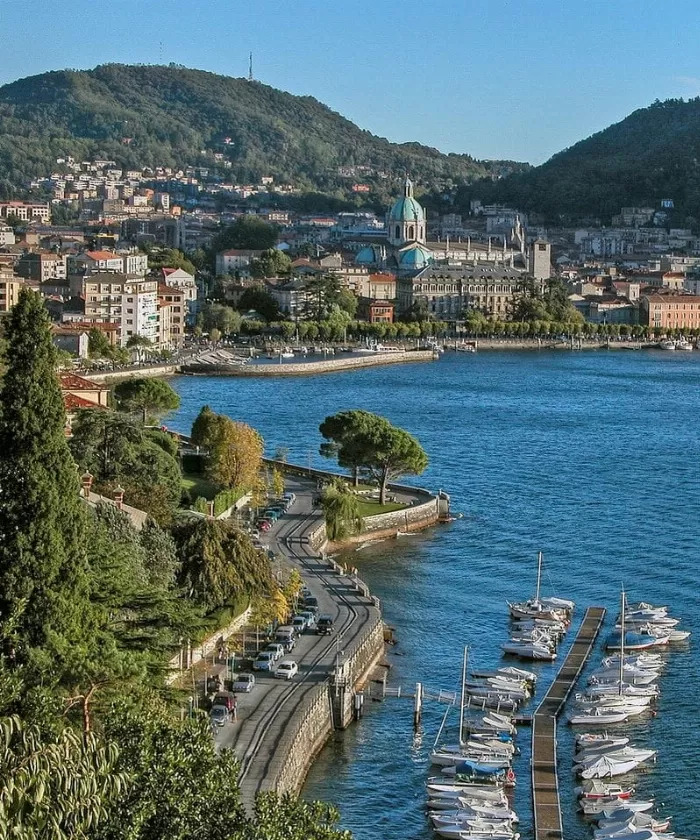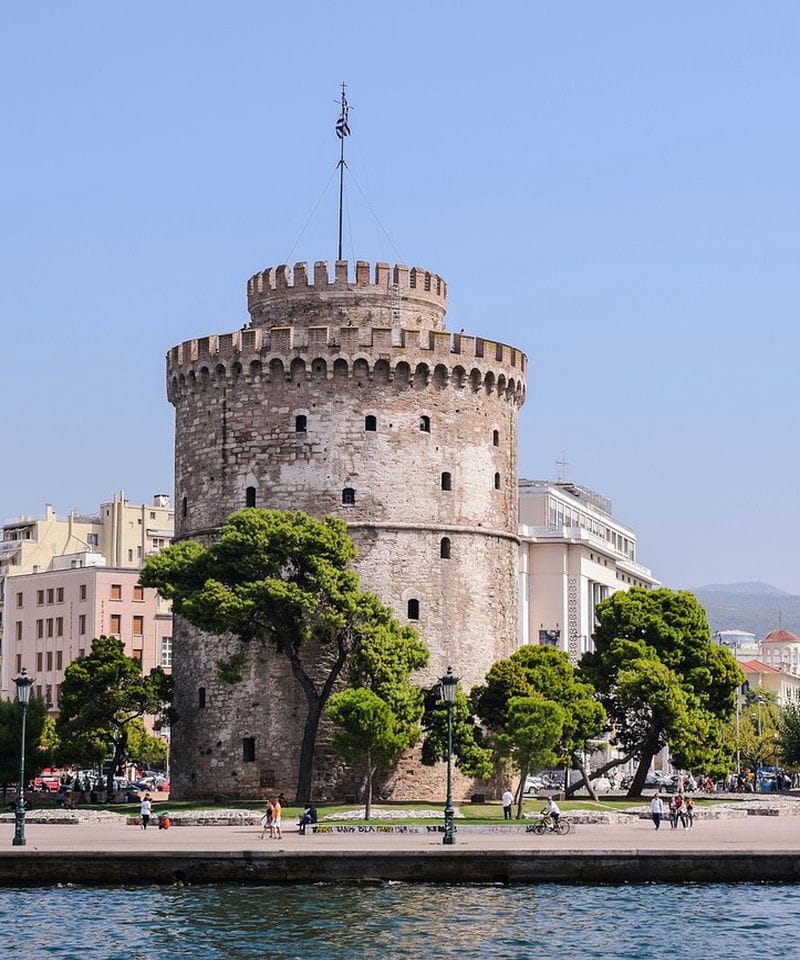
Things to Do in Milan: Top Attractions and Hidden Gems
Key Takeaways
- There is a great variety of things to do in Milan that appeal to all tastes.
- Milan boasts iconic landmarks and cultural experiences.
- Art and history are deeply embedded in the city's attractions.
- Leisure activities and day trips enhance the Milan experience.

Milan, Italy, is a bustling metropolis in Northern Italy, and a treasure trove of historical landmarks, cultural experiences, and modern attractions.
From its iconic Duomo di Milano, a stunning example of Gothic architecture, to the artistic marvels hidden in every corner, Milan offers a delightful mix for every traveler.
The city's rich tapestry ensures that visitors are never short of things to see and do.
A visit to Milan wouldn't be complete without exploring the Galleria Vittorio Emanuele II, a prime example of 19th-century grandeur and a haven for luxury shopping.
Art enthusiasts will be captivated by Da Vinci's 'The Last Supper,' one of the most famous murals in the world.
These attractions, alongside leisurely strolls through the charming Navigli District, paint a comprehensive picture of what Milan has to offer.
Whether it's wandering through the historic halls of the Sforza Castle or experiencing the vibrant arts scene in the Brera District, Milan promises a memorable journey.
Parco Sempione offers a serene escape amidst the city's hustle, and the possibility of day trips to nearby destinations enriches the Milanese experience.
Discover the Iconic Duomo di Milano
The Duomo di Milano, also known as Milan Cathedral, is a breathtaking example of Gothic architecture.
Its intricate façade, notable spires, and iconic golden Madonnina make it a centerpiece of Milan's cultural and historical landscape.
History and Significance of the Duomo
The construction of the Duomo di Milano began in the 1380s and took nearly six centuries to complete, finally concluding in the 1960s.
It has served as a religious and cultural cornerstone in Milan, demonstrating the city's dedication to both faith and artistry.
The cathedral has witnessed countless historical events, and its legacy is deeply embedded into the city's identity.
Serving not just as a place of worship, the Duomo represents Milan's rich cultural heritage and resilience through time.
Architectural Features
In the city centre, the Duomo showcases an intricately decorated Gothic façade which is adorned with numerous statues and carvings.
The exterior is famous for its spires, with the tallest one supporting the golden statue of the Madonnina, a symbol of Milan.
Inside, the magnificent Gothic cathedral boasts an impressive array of stained glass windows that tell biblical stories and create a vibrant play of light.
The detailed stone carvings and vast nave highlight architectural prowess and the dedication involved in its construction.
Visiting Tips
When planning a visit, it is advisable to buy tickets in advance to avoid the long queues.
Early morning or late afternoon offers the least crowded experiences.
Visitors should adhere to dress code requirements as it is a working cathedral; shoulders and knees should be covered.
Don't miss the opportunity to ascend to the rooftop terraces, which provide stunning views of Milan, Piazza del Duomo, and an up-close look at the intricate spire work.
Explore the Historical Galleria Vittorio Emanuele II

The Galleria Vittorio Emanuele II in Milan is not just a hub for luxury shopping but also a significant historical landmark. It is Italy's oldest shopping mall!
Visitors can immerse themselves in its rich history, high-end boutiques, and exceptional dining experiences.
Historical Background
Built between 1865 and 1877 and designed by Giuseppe Mengoni, the Galleria Vittorio Emanuele II is one of Italy's oldest active shopping galleries.
Named after Victor Emmanuel II, the first king of the Kingdom of Italy, it showcases four-story double arcades and an impressive glass and iron roof.
During World War II, it suffered severe damage but was meticulously restored by 1955.
The Galleria has been a centerpiece of Milan's cultural and social life.
Its architectural splendor and innovative design make it a landmark worth visiting.
The structure features intricate mosaics, stunning frescoes, and a glass dome that offers a breathtaking view.
Shopping and Dining
The Galleria Vittorio Emanuele II is home to numerous luxury fashion boutiques, including Prada, Gucci, and Louis Vuitton.
Shoppers can explore high-end stores that offer everything from fine leather goods to haute couture.
Dining in the Galleria is equally prestigious.
Renowned restaurants such as Ristorante Savini and Biffi provide gourmet meals in an elegant setting.
Whether you are looking for an exquisite Italian dish or a delightful pastry, the culinary options are vast and varied.
Unique Experiences
A visit to the Galleria offers more than just shopping and dining.
One of the Galleria's unique experiences is the tradition of spinning on the mosaic bull's testicles for good luck, situated in the central octagon.
Additionally, the Galleria often hosts art exhibitions and cultural events that enrich its historical ambiance.
Stunning views from the Galleria's rooftop provide a scenic overlook of Milan, including the nearby Duomo.
Seasonal decorations, particularly during the winter holidays, add to the magical aura of the space by enhancing its majestic character.
Exploring the Galleria Vittorio Emanuele II allows visitors to appreciate a blend of historical majesty, fashionable elegance, and unforgettable dining experiences.
Marvel at Leonardo da Vinci's 'The Last Supper'

Leonardo da Vinci's 'The Last Supper' is a must-see masterpiece in Milan, renowned for its historical significance and artistic brilliance.
Exploring this iconic painting provides an enriching experience for art enthusiasts and casual visitors alike.
The Painting's Location and History
Located in the convent of Santa Maria delle Grazie in Milan, 'The Last Supper' was commissioned as part of renovations to the church and its convent buildings in the late 15th century.
Painted between 1494 and 1498, the fresco represents Jesus Christ's final meal with his apostles.
The site was inscribed as a UNESCO World Heritage Site in 1980, recognizing its outstanding universal value.
As a key work of the Renaissance period, this masterpiece exemplifies Leonardo da Vinci's innovative techniques and profound understanding of human emotion and perspective.
Booking Tickets and Tours
To visit 'The Last Supper,' it's essential to book tickets well in advance, as the site is extremely popular and often sells out.
There are various ticket options available:
- Adults over 25: €15
- Adults between 18-25: €12
- Children under 18: Free (reservation required)
Visitors can choose between self-guided tours and guided tours, with options that include skip-the-line access for convenience.
Some tours combine 'The Last Supper' visit with other attractions like the Milan Cathedral (Duomo) and Sforza Castle.
Visitor Tips
- Visitors are encouraged to arrive early to accommodate security checks.
- Headsets are often provided during guided tours to ensure everyone can hear the commentary clearly in the crowded setting.
- Photography is usually prohibited to preserve the painting.
- It's also recommended to take some time to explore the rest of the Santa Maria delle Grazie church and its surroundings, providing a fuller appreciation of the site's historical context.
- For those keen on a deeper experience, choosing a tour that includes background stories and historical details about the painting and Leonardo da Vinci's life can be incredibly rewarding.
Leisurely Stroll Through the Navigli District
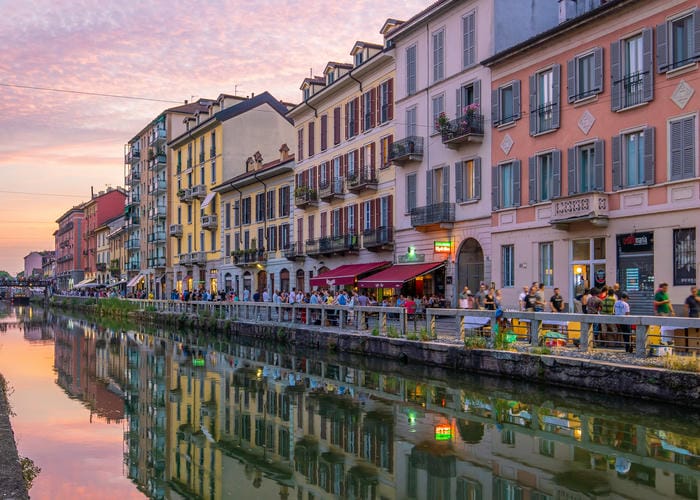
Navigli in Milan offers picturesque canals, historical landmarks, numerous activities, and a variety of dining options that attract locals and tourists alike.
Canals and History
The Navigli District is renowned for its historic canals, which date back to the 12th century.
These man-made waterways were originally built to facilitate the transportation of goods and connect Milan with surrounding towns.
Today, they remain an iconic feature, adding charm and depth to the neighborhood.
Visitors can enjoy boat tours along these canals, providing a unique perspective on the area's history and architecture.
During an evening stroll, you can admire the scenic reflections of historic buildings in the water, creating a tranquil and almost timeless atmosphere.
The most notable canals are Naviglio Grande and Naviglio Pavese, which define the district's layout and soul.
Activities and Attractions
Navigli offers a vibrant array of activities for all types of travelers.
It's a hotspot for art lovers, with many galleries and studios showcasing local and international talent.
The Navigli Antique Market, held monthly, is perfect for those interested in rare finds and unique souvenirs.
For a relaxing day, visitors can simply walk along the canals and enjoy the lively street performances and local crafts.
The district comes alive in the evenings, making it ideal for an evening stroll where the lights reflect beautifully on the canal waters, adding to the district's romantic allure.
Culinary Hotspots
Culinary enthusiasts will find Navigli bursting with dining options.
The neighborhood is famous for its 'aperitivo' culture, where one can enjoy a pre-dinner drink accompanied by complimentary snacks.
Popular spots include bars and cafes lining the canals, such as BGood Café, known for its excellent coffee and vegetarian brunch.
Restaurants here offer a mix of traditional Italian cuisines and modern twists, ensuring a delightful culinary journey.
Places like La Prosciutteria and Il Vinaccio are local favorites.
The combination of flavorful dishes and vibrant atmospheres makes Navigli a must-visit for food lovers exploring Milan.
Discover the Sforza Castle and Its Treasures

The Sforza Castle (Castello Sforzesco) in Milan is a historical fortress showcasing impressive architecture, rich history, and a wide array of artworks and artifacts.
Visitors can explore both its grand construction and the treasures it houses, from masterpieces by Leonardo da Vinci and Michelangelo to fascinating historical documents.
Historical Significance
Sforza Castle, constructed in the 15th century, has played a significant role in Milan's history.
Initially built by Francesco Sforza, Duke of Milan, it served as a defensive fortress.
Over the centuries, the castle transitioned into a ducal residence.
The architectural evolution reflects the political and cultural changes Milan underwent.
The castle faced destruction and reconstruction multiple times.
It was almost demolished in the 19th century but was restored to preserve Milanese heritage.
Today, it stands as a symbol of Milan's resilience and rich historical fabric.
Main Attractions
The Sforza Castle houses several notable attractions.
One of the highlights is Michelangelo’s Rondanini Pietà, housed in the Museum of Ancient Art.
This unfinished sculpture holds significant artistic value.
Additionally, visitors can appreciate Da Vinci’s contributions to the Sala delle Asse showcasing his frescoes.
Museums within the castle, like the Egyptian Museum and the Museum of Musical Instruments, offer diverse collections.
The vast art collection includes works from the Renaissance to modern times.
The castle’s extensive library and archive feature many historical documents crucial for researchers and history enthusiasts.
Visitor Information
Sforza Castle is located at Piazza Castello in Milan. It is easily accessible by public transportation, including metro and bus services.
The site is open daily, with varying hours depending on the season. Admission fees apply, with reduced rates for students, seniors, and groups.
Guided tours are available and recommended for those wishing to fully appreciate the intricate details and historical context of the artworks and architecture.
Comfortable walking shoes are advisable due to the size of the castle grounds.
Visitors can also enjoy scenic views of the surrounding Parco Sempione, ideal for leisurely strolls before or after exploring the castle.
For any additional information, it is advisable to check the official website or contact the visitor center.
Artistic Journey in the Brera District
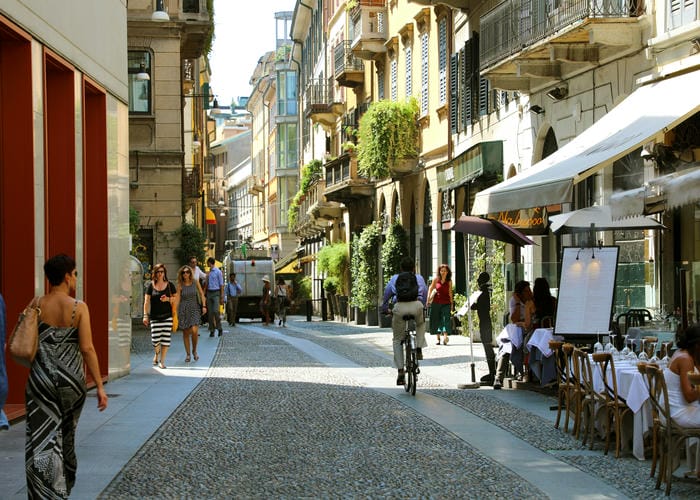
The Brera District in Milan offers a blend of historic art and contemporary creativity, located within walking distance of the city's key points of interest, such as Piazza della Scala.
Visitors can immerse themselves in the bohemian ambiance, explore key cultural attractions, and enjoy refined dining and shopping experiences.
Bohemian and Artistic Vibes
The Brera District is famously known as the 'Artists' Quarter' due to its rich artistic history.
The transformation of this area began in the 19th century, leading to its current bohemian atmosphere.
Artists and creatives have long been drawn to Brera, making it a hub for cultural and artistic expression.
Strolling through its cobbled streets, one can find numerous art studios, boutiques, and open-air markets.
This unique environment fosters a creative spirit and provides an ideal setting for art lovers.
Key Attractions
When you visit Milan, a visit to Brera would be incomplete without exploring its key attractions.
The Pinacoteca di Brera is a highlight, housing masterpieces by Italian greats such as Raphael and Michelangelo.
This art gallery is divided into 36 rooms, each specializing in different periods and movements, offering an expansive overview of Italian painting.
Live music events are held once a month at the Pinacoteca, adding a dynamic cultural experience.
Nearby, the Brera Academy of Fine Arts, established in 1776 by Empress Maria Theresa, continues to be a significant influence in the area.
This historic institution played a vital role in transforming Brera into the esteemed artistic district it is today.
Refined Tastes
Brera is not only about art; it also caters to refined tastes in dining and shopping.
Numerous cafes and restaurants line the streets, offering exquisite Italian cuisine and perfect spots for people-watching.
From traditional trattorias to upscale dining, there are options to satisfy every palate.
Shoppers will appreciate the array of stylish boutiques and shops selling everything from contemporary fashion to unique art pieces.
The combination of artistic heritage and modern elegance makes Brera a must-visit for those seeking a sophisticated cultural experience.
Whether it's savoring a fine meal, shopping for a unique art piece, or simply soaking in the atmosphere, Brera offers an enriching cultural experience in the heart of Milan.
Relaxation and Culture at Parco Sempione

Parco Sempione offers an ideal combination of relaxation and cultural experiences in Milan.
Visitors can enjoy the park's unique features, architecture, and various leisure activities.
Park Features
Parco Sempione is located northwest of Milan, covering approximately 116 acres.
It was commissioned in the late 19th century to provide a green space for the city's residents.
Castello Sforzesco, a historic castle first built in the 1300s, marks the eastern entrance.
Key landmarks include the Arco della Pace, a neoclassical triumphal arch located at the northern end, symbolizing peace.
The park also features the Torre Branca, a panoramic viewpoint where visitors can enjoy stunning views of the city.
Activities and Leisure
Parco Sempione is perfect for various leisure activities.
Visitors can enjoy walking, jogging, and cycling paths throughout the park.
Many choose to relax at the artificial lake or find a cozy spot for a picnic.
For those interested in culture, the Civic Aquarium of Milan and the Palazzo dell'Arte frequently host exhibitions and events.
Additionally, open green spaces and shaded areas make it ideal for yoga or reading.
Playing fields and playgrounds offer recreational opportunities for both children and adults.
Public events and concerts are also common, providing entertainment under the open sky.
Day Trips to Enrich Your Milan Experience
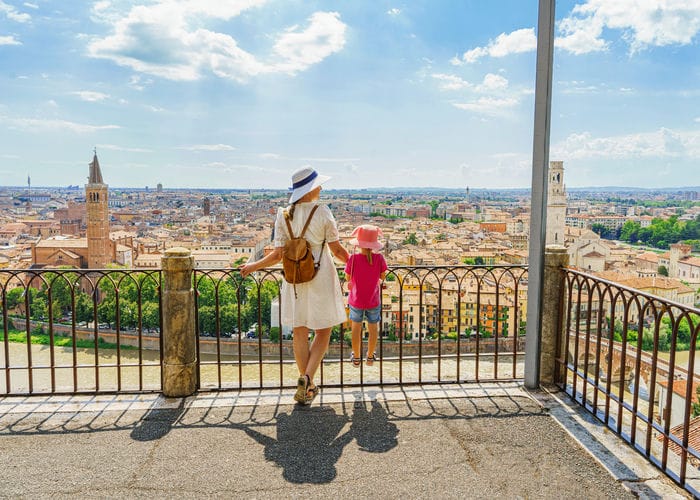
For travelers looking to explore beyond Milan's charming neighborhoods, several day trips offer enriching experiences.
Lake Como, situated in the Lombardy region, promises picturesque views and serene lakeside walks.
A roundtrip ticket to this beautiful spot is approximately 54.55 EUR.
Nearby, Bergamo presents a blend of historical sites and vibrant Italian culture.
The Dolomite Mountains are ideal for those seeking breathtaking natural landscapes.
This area provides opportunities for hiking and photography, perfect for a day of fresh air and adventure.
Verona, the city of Romeo and Juliet, offers a romantic and historic escape. This city is rich with medieval architecture and inviting piazzas.
Whether one opts for self-guided tours or organized trips, these day trips enhance any Milan itinerary, showcasing the diversity of Lombardy.
Final Thoughts

Milan, a city steeped in history and pulsating with modernity, offers a journey through time and culture that captivates every visitor.
In every cobblestone street and towering cathedral, the spire tells a story of resilience, creativity, and cultural splendor.
Whether exploring ancient fortresses or savoring a moment of tranquility in a city park, Milan promises an unforgettable journey that celebrates the past while embracing the future.
As you navigate its streets and absorb its intricate combination of elements, Milan reveals itself not just as a destination, but as an enduring masterpiece in its own right!





